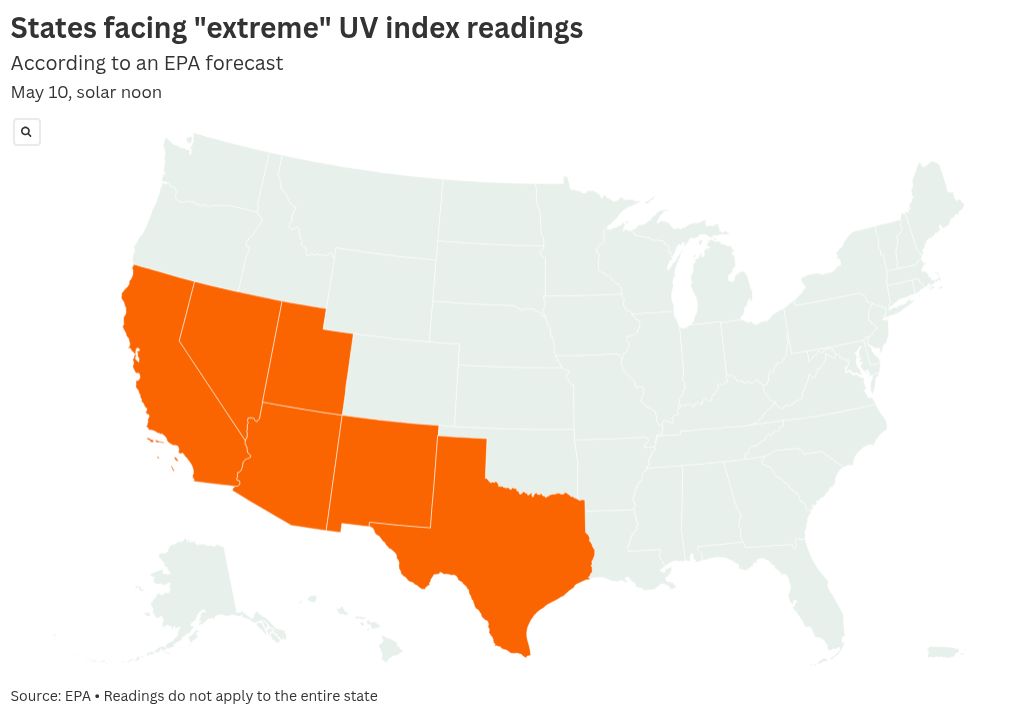Millions of Americans across seven states in the Southwest are facing high levels of ultraviolet (UV) radiation levels from the sun later this week, a forecast map from the Environmental Protection Agency (EPA) showed.
Why It Matters
Per official guidelines from the EPA and National Weather Service (NWS), levels in this area present an “extreme” risk of harm from unprotected sun exposure.
What To Know
The UV index runs on a scale of one to 11. The levels, and their corresponding advice are as follows:
1—2: Low—Minimal risk from UV rays for the average person.
- Wear sunglasses on bright days.
- In winter, snow can reflect UV and nearly double exposure.
- Use SPF 30+ sunscreen if you burn easily.
3—5: Moderate—Moderate risk of harm from unprotected sun exposure.
- Cover up, wear a hat and sunglasses.
- Use SPF 30+ sunscreen.
- Stay in the shade near midday when the sun is strongest.
6—7: High—High risk of harm from unprotected sun exposure.
- Limit sun time between 10 a.m. and 4 p.m.
- Wear protective clothing, sunglasses, and SPF 30+ sunscreen.
8—10: Very High—Very high risk of harm; sun protection is essential.
- Take extra precautions including wide-brimmed hats and long sleeves.
- Minimize exposure between 10 a.m. and 4 p.m.
- Be aware: white sand and similar surfaces reflect UV and increase exposure.
11+: Extreme—Extreme risk of harm; unprotected skin can burn in minutes.
- Avoid sun exposure from 10 a.m. to 4 p.m.
- Reapply SPF 30+ sunscreen every 2 hours.
- Seek shade, wear full coverage, and use sun protection.

According to the EPA’s UV index forecast for May 10, solar noon, parts of Texas, New Mexico, Utah, Arizona, Colorado, Nevada and California could see levels of at least 11 on this day.
Solar noon is the time when the sun reaches its highest position in the sky at a given location.
At this level, officials advise that skin “can burn in minutes,” and exposure during midday hours, from 10 a.m. to 4 p.m., should ideally be avoided.
What People Are Saying
Anthony Young, emeritus professor of experimental photobiology, dermatology, at King’s College, London told Newsweek: “The UV index (UVI) is a measure of the sunburning power of sunlight … The higher the UVI the shorter the time you need in the sun to burn.”
Richard Weller, professor of medical dermatology, at the U.K.’s University of Edinburgh told Newsweek that sunlight can cause photoaging—premature aging of the skin as a result of prolonged and repeated exposure to UV radiation.
“Sunburn is a risk factor for melanoma skin cancer, which is the most serious of the skin cancers,” he added.
What Happens Next
The UV index forecast map is created daily using NWS forecast data.
Those interested in finding the time of solar noon in their location can use the sunrise-sunset-solar noon calculator at the NOAA website.
The post Millions of Americans Warned to Avoid the Sun in 7 States appeared first on Newsweek.




